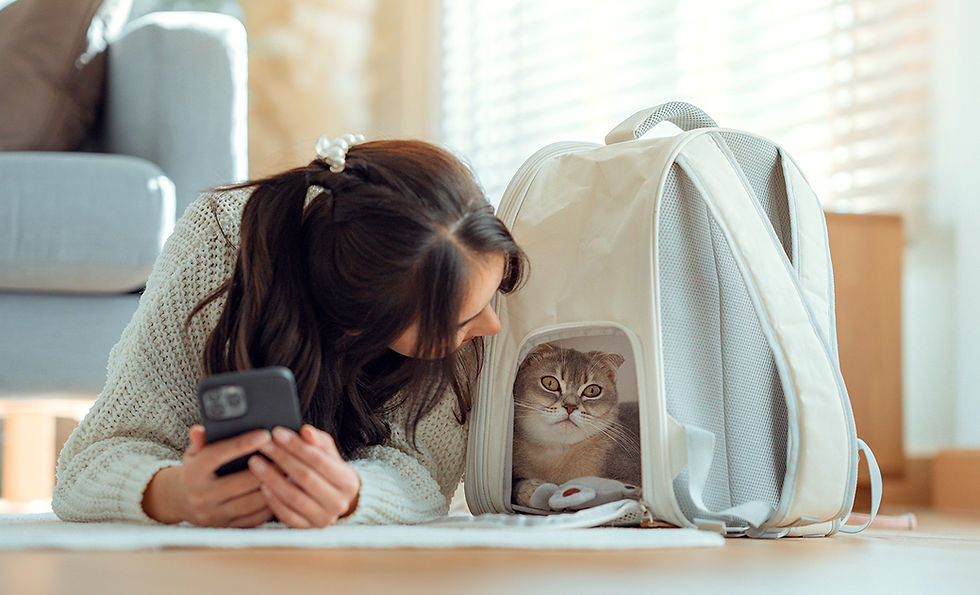- Erin Sole
- Apr 30
- 3 min read
You know, cats might have nine lives, but that doesn't mean they're immune to health problems. Today, we're diving into a chilly topic that's more serious than most people realize: cat hypothermia.
In this blog, we'll cover:
What is hypothermia in cats
Causes of cat hypothermia
Signs and symptoms of hypothermia in cats
What to do if you suspect hypothermia in your cat
What happens if hypothermia is left untreated
This blog provides what you need to know about cats developing hypothermia. If you have a dog and are worried about hypothermia, or just want to learn more for your pup, you can read about hypothermia in dogs here.

What is Cat Hypothermia?
Hypothermia in cats is not just your feline friend feeling a little cold. It's a real, potentially life-threatening condition where a cat's body temperature drops dangerously low. Normally, cats have a body temperature of around 100.5 to 102.5 ºF. In hypothermia, we're talking about temperatures dropping below 100ºF. So, how does this happen?
Causes of Hypothermia in Cats
Hypothermia occurs when a cat loses heat faster than they can produce it.
Possible causes for a cat in hypothermia:
• Cold weather and exposure to freezing temperatures are obvious culprits, but they're not the only ones. See below.
• Wet fur from rain or a dip in a puddle can also affect your cat's body heat.
• Medical procedures requiring anesthesia come with a high rate for hypothermia in cats
• Sepsis
• Heart disease or kidney disease
Additionally, underlying illnesses like heart disease or kidney disease can cause hypothermia in cats. Certain medications may lead to hypothermia in felines as well. Lastly, if a cat sustains trauma, hypothermia can be a secondary condition that shows up later.
Critical information: it's not just outdoor cats at risk for hypothermia; indoor cats can suffer from hypothermia too.
The Signs of Cat Hypothermia You Need to Know
Cat owners: take note of your perfect pet's behaviors. Knowing the symptoms of hypothermia in cats can be the difference between a close call and a tragedy.
Signs and symptoms of hypothermia in cats:
Shivering: Shaking uncontrollably is often the first sign.
Lethargy: Cats with hypothermia may appear listless or unresponsive.
Weakness: If your cat is struggling to move or stand, it’s a red flag.
Pale gums: Check your cat’s gums. If they are pale or blue, it’s an emergency.
Cold to the touch: Feel your cat’s ears and paws. Are they ice-cold? Don't ignore it; it's time to see the emergency vet.
These symptoms are not just signs of hypothermia; they could be indicative of many different disease processes. Regardless, they all mean your feline friend should be seen by a veterinarian sooner rather than later.

Seek Immediate Veterinary Attention for Hypothermia in Your Cat
You've spotted the warning signs... so, how do you avoid a catastrophe? We can't stress this enough: Time is of the essence. Hypothermia can lead to all sorts of complications.
Complications from hypothermia in cats:
Frostbite
Stiffness
Kidney failure due to slowed circulation
Weakened respiratory muscles affecting breathing
If left untreated, hypothermia can be fatal.
If you suspect your cat may be suffering from hypothermia, call your nearest VEG ER for Pets location!
What If Cat Hypothermia Goes Untreated?
Untreated hypothermia will lead your cat down a slippery slope. We're talking about metabolic imbalances and, in the worst-case scenario, death. That's why if you suspect your cat has hypothermia, call VEG or your nearest emergency vet right away.
VEG Vet Hospital is Open 24 Hours for Emergency Care for Cats and All Pets
Our team of skilled vet professionals at VEG ER for Pets is available 24 hours a day to ensure your cat receives the best emergency care possible. Don't take chances with your cat's health. Cat hypothermia is a serious issue, but being informed and acting quickly can make all the difference. Keep your cats warm and cozy, and always seek professional help if something seems off.




